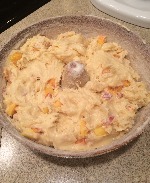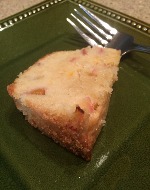The Peach A Classic Sign for Summer
Ah, the peach; a classic sign of summer, a staple in warm-weather recipes, and anticipated
at farmers' markets and stands across the country from June through August. We love
t his sweet, juicy fruit, but how much do we really know about its history, nutritional
value, or even how to cook with it?
TEXARKANA, Ark. –
 |
 |
 |
||
| Ingredients Needed to Make Your Peach Bundt Cake | All Ingredients are Mixed Together in Bundt Pan and Is Now Ready for the Oven | The End Result is a Delicious Slice of Cake |
Ah, the peach; a classic sign of summer, a staple in warm-weather recipes, and anticipated at farmers' markets and stands across the country from June through August. We love this sweet, juicy fruit, but how much do we really know about its history, nutritional value, or even how to cook with it?
Cultivation of peaches began in China as early as 2000 B.C. By 300 B.C. Greeks and Persians were enjoying peaches. In the first century A.D., Romans began cultivating peaches. From Italy, the cultivation of peaches spread throughout Europe and to the Americas, where the early settlers planted them all along the eastern coast. By the mid-1700s, peaches were so plentiful in the United States that botanists thought of them as native fruits.
One large peach has only 68 calories, 17 grams of carbohydrates, 3 dietary fiber and 2 grams protein. They are fat free, cholesterol free, sodium free, a good source of vitamins A and C.
Fresh peaches should be available in our area until August. You’ll find the tastiest fruits at local farmers markets, roadside stands and u-pick farms, where they are likely picked the day before being brought to the market or stand. Those purchased at supermarkets may not be as tasty, due to the fact that they are often picked before they are fully ripened and shipped to the store.
If you want to make it ripen more quickly place the fruit in a single layer in a large paper bag. Fold the top down and check it every day to see if it is ripe. Peaches should not be refrigerated before ripe because this could cause them to lose flavor and have a mealy texture.
There are two basic types of peaches, clingstone and freestone. With clingstone peaches, the flesh “clings” to the "stone" of the peach, making it difficult to separate, and thus more suitable for processing and preserving into jams, jellies and preserves. This variety retains its flavor and soft texture during processing.
The pit of freestone peaches "freely" separates from the flesh, making it ideal for fresh consumption. Freestone peaches are generally larger than clingstones with a firmer, less juicy texture. While most commonly eaten fresh, these peaches may also be frozen and dried.
Once you have chosen the type of peach, look for a yellow or creamy color. The amount of rosy “blush” on the surface is characteristic of the variety, not ripeness. Remember that peaches bruise easily, so handle them carefully.
To test them for ripeness, press the fruit gently with your finger. The fruit should feel firm, but have a little give. Most will have a sweet fragrance. Avoid peaches that are too soft, unless you plan to use them immediately. These are often overripe and will spoil quickly.
Fresh peaches make great desserts, and quick breads. Instead of peeling, remove the skin by dipping the peach in boiling water for 20 to 30 seconds. Then immediately dip into ice cold water and the skin will slip right off. Riper peaches need less scalding time to loosen the peels.
Remember peeled peaches brown rapidly when exposed to air. To prevent this, soak halves or slices for 5 minutes in 1 quart of water with 3 tablespoons lemon juice and 2 crushed 500-milligram vitamin C tablets.
Peaches are very versatile and can be tossed in brown sugar and added to waffles and pancakes; add slices to cereals, both hot and cold; put them in salads or smoothies, or puree them and add to homemade ice cream.
For more information on peaches, including recipes, click Arkansas Fresh Peaches or contact me at the University of Arkansas System Division of Agriculture, Miller County Extension in the courthouse, e-mail chaley@uada.edu or call 870-779-3609. You can also get great tips on facebook at UAEXMillerCountyFCS/CarlaHaleyHadley, twitter at @MillerCountyFCS and Instagram millercountyfcs_carlahadley. Visit me at the Gateway Farmers Market Saturday morning, July 11th from 8:00 until 11:00.
This Peach Pound Cake recipe is the same one I use for my Blueberry Pound Cake, I just changed the fruit. It is always a favorite and the sugared pan gives it a wonderful crust.
Peach Pound Cake
1 cup butter, softened
2 cups sugar
4 eggs
1 teaspoon vanilla
1 teaspoon baking powder
1/2 teaspoon salt
3 cups flour (divided)*
2 cups (approximately 1 pound) fresh peaches, pitted and chopped
*2 cups of flour in batter, 1 cup to dredge peaches
Cream butter and sugar until light and fluffy. Add eggs, one at a time. Add vanilla. Mix in baking powder, salt and 2 cups of flour. Fold in peaches that have been dredged in 1 cup flour. Pour into 10-inch tube pan which has been buttered and sprinkled with sugar. Bake at 325 degrees F for 60 to 70 minutes. Allow to cool in pan for 10-15 minutes before inverting onto wire rack to serve completely. This cake is great served alone or can be served with a dollop of whipping cream. Serves 10-12.
NOTE: Use butter in this cake. Using margarine just isn’t the same.
By Carla Haley-Hadley
County Extension Agent - FCS
The Cooperative Extension Service
U of A System Division of Agriculture
Media Contact: Carla Haley-Hadley
County Extension Agent - FCS
U of A Division of Agriculture
Cooperative Extension Service
400 Laurel Street, Suite 215 Texarkana AR 71854
(870) 779-3609
chaley@uada.edu
The Arkansas Cooperative Extension Service is an equal opportunity institution. If
you require a reasonable accommodation to participate or need materials in another
format, please contact your County Extension office (or other appropriate office)
as soon as possible. Dial 711 for Arkansas Relay.
Pursuant to 7 CFR § 15.3, the University of Arkansas System Division of Agriculture
offers all its Extension and Research programs and services (including employment)
without regard to race, color, sex, national origin, religion, age, disability, marital
or veteran status, genetic information, sexual preference, pregnancy or any other
legally protected status, and is an equal opportunity institution.